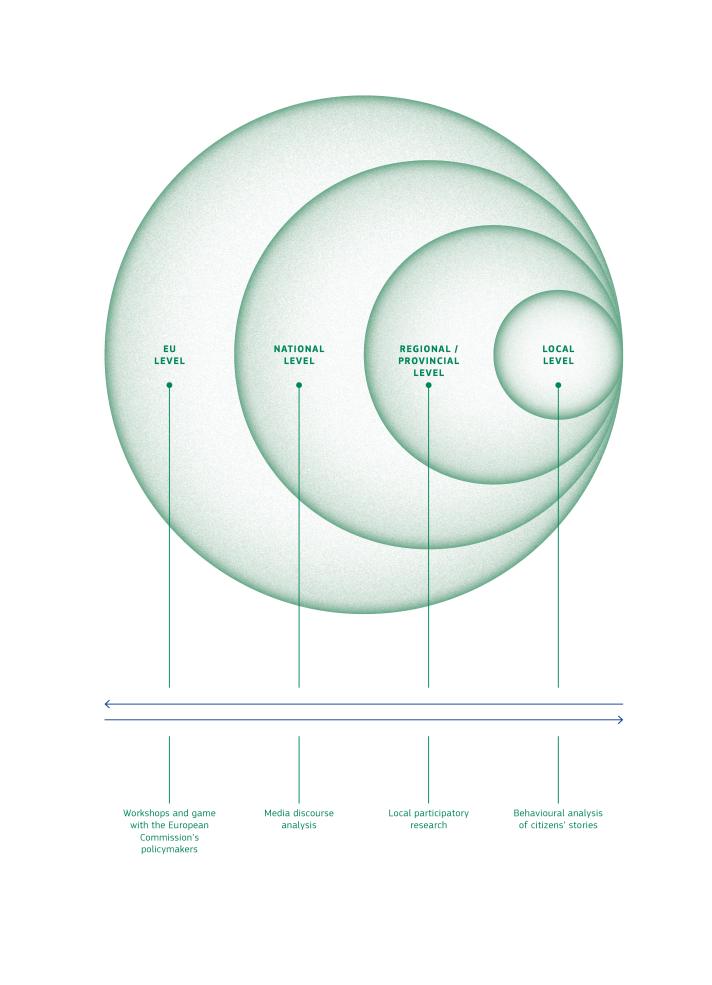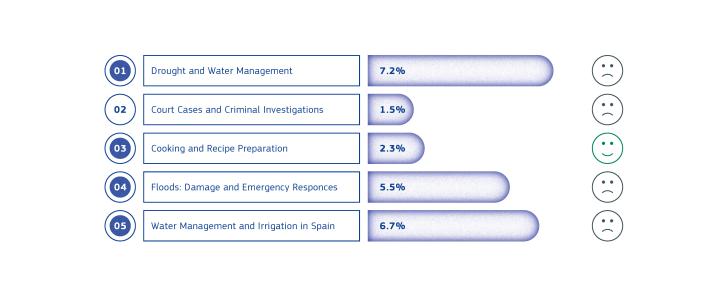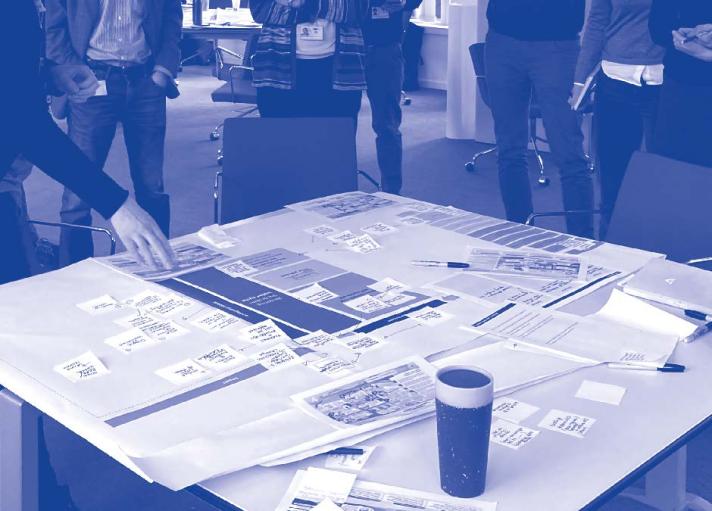
How can we bridge the gap between water policy and action on the ground? What if by engaging citizens, policymakers, scientists and stakeholders across multiple governance levels, we explore new ways of thinking, collaborating, and decision-making? The Water Resilience Experiment is an initiative of the EU Policy Lab where we explored exactly that, using participatory design, behavioural insights, and visual tools to tackle water resilience challenges.
This blogpost is the first of a series of articles diving deeper into the contents and insights of this report. Stay tuned for more!
How can we make water resilience a reality?
In our Water Resilience Experiment, we set out to bridge the gap between policy and implementation by rethinking how we collaborate, design, and make decisions. Using a mix of participatory design, behavioural insights, and hands-on fieldwork across Europe, we brought together policymakers, stakeholders, and communities to explore new ways of tackling water challenges. Water resilience connects deeply with diverse human and ecological activities, from agriculture to health and energy.
How did we approach it?
We adopted a holistic, cross-cutting, and systemic approach to explore water resilience beyond specific regulations, focusing instead on the organisational structures and divisions shaping water governance. To do this, we combined design for policy and behavioural insights. Design helped us to rethink how policies are created and implemented. Through participatory practices, visual tools, and gamification, we enabled policymakers to step outside their usual ways of working, opening space for systemic and creative thinking. Behavioural insights explored the human dimension behind water policy, from EU policymakers’ views on barriers to implementing water policies to how citizens perceive and act on water issues.

The aim was to explore the influence of the European Commission's organisational culture on the formulation and adoption of water resilience policies in the EU. At the same time, we spoke to citizens and stakeholders across the EU Member States using various fieldwork and methods to gather information and bring insights about implementation and feedback collection from stakeholders.
At the citizen level, we collected stories to explore and understand how citizens and stakeholders across the EU experience water in their daily lives. These narratives unveil the way water holds a place in individuals’ and communities' memories and identities. This went beyond the current consultation practices, enriching the policy discourse with personal and professional insights.
37% of all stories in the EU relate to health and wellbeing. These stories are mostly positive (70%), associated with gratefulness for what nature has to offer and happiness.
“Being near water, or rivers, lakes, the sea, calms and relaxes me. It is important for me, when I am overwhelmed, to have easy access to water reservoirs or other bodies of water. Water is flowing and can take any form, this inspires me and we humans are mostly made of water, so literally, we can assume that we can also learn to deal with whatever situations life brings us […]”
For further details, see the full report on citizen stories (Dupoux et al. 2025b)
At the regional/provincial governance level, we collaborated with five innovation labs from Denmark, Croatia, Italy, Lithuania and Portugal. These labs ran design-driven participatory research, investigating different aspects of water resilience linked to their local area, involving citizens, local communities, or key national stakeholders.
“[…] I feel that conversations aren’t held at all. Inhabitants and activist groups often hold an aggressive tone, which in turn makes decision-makers hide and shield themselves. It is hard to blame them though because changes are happening on their doorstep and nobody decided to knock and say ‘hello, here’s what’s up…”
This is a quote from a community leader in Croatia who performed research on how to explore what is and what could be the role of the communities in revitalising river landscapes. The aim is to learn how to connect bottom-up and top-down efforts to produce a lasting and sustainable change.
For further details, see a previous blog post and the full report on regional water policies (Arrigoni et al., 2025)
At the national level, we used the Europe Media Monitor (EMM), the JRC’s news gathering text mining engine to collect relevant articles related to water and explore how media outlets are reporting on water in the six most spoken languages of the EU (Dutch, French, German, Italian, Polish, and Spanish).
For further details, see the full report on EU water media analysis (Dupoux et al. 2025a)
At the European level, we tried different strategies related to ways of working, collaboration, and decision-making. To address the issue of fragmented water policies, the project tested new, collaborative methods across departments. Through workshops, we encouraged policymakers to use visual and systemic thinking through different activities that promoted new ways of collaborating and decision-making. This helped participants to go beyond textual, linear, and verbal reasoning to tackle complex challenges.
We also developed a ‘Water Reflections’ serious game that enables policymakers to role-play, promote teamwork, learn worldwide practices, and envision a water resilience strategy. We will explain how this works in a future blog post, so stay tuned!
For further details, see the full report on the Water Reflections Game (Hamarat et al., 2025).
What did we observe?
The research identified three aspects that are essential for a comprehensive approach to water resilience:
- Framing the topic. How we frame water-related issues significantly influences our understanding and approach to solving them.
- Internal organisational culture. The Commission’s internal practices affect the creation and execution of cross-cutting water policies.
- Implementation and local knowledge. Collaborating across different levels of governance, and integrating regional and local experiences can build trust, enhance public engagement and ensure policies meet local needs.
What’s next
Drawing from our observations, the water resilience experiment proposes eight transformative actions to tackle water resilience both inside and outside the European Commission. We propose these ideas in actionable and simple ways to encourage uptake. The actions focus on:
- New methods that could complement the Commission’s traditional tools
- Projects that can support the implementation process by integrating feedback more quickly and regularly into policymaking
These proposals target individual policymakers, water-related groups, and communities both within the Commission and beyond.
Why it matters for policymaking
Our research reveals a strong need to change how things are done both internally and externally. This means creating more and new spaces for collaboration with Member States and regions, diversifying methods, and tackling implementation challenges together. To succeed, innovative approaches should be co-designed with policymakers across Commission departments, moving away from a traditional consultation and negotiation model towards shared ownership and more open, participatory policymaking.
As Europe faces multiple interconnected crises, holistic, cross-cutting, and systemic approaches will become increasingly crucial across policy domains. The water resilience experiment shows that by listening differently, collaborating creatively, and designing with people, we can build more resilient, adaptive, and impactful policies.
Beyond water resilience, this experiment offers valuable lessons for applying a broad perspective to other policy areas as well. By expanding on this work, we hope to provide both evidence and solutions regarding possible internal interventions and more holistic, cross-cutting, and systemic approaches at the Commission.
Find the full Water Resilience Experiment report and stay tuned for our upcoming blog posts on the topic!
Details
- Publication date
- 7 April 2025
- Author
- Joint Research Centre
- Department
- Directorate-General for Environment
- EU Policy Lab tags
- Design for policy
- Behavioural insights
- #OURFUTURES








